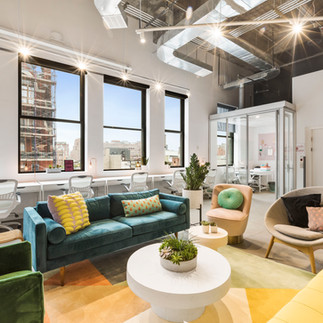Benefits of a Well-Designed Office Layout
- Spaces Taylored

- Aug 24, 2023
- 3 min read
Updated: Nov 18, 2024
A well-designed office layout can offer numerous benefits to both employees and the organisation as a whole. Here are some key advantages of good office design:
Benefits of a Well-Designed Office Layout:
Enhanced Productivity
Collaboration and Communication
Morale and Job Satisfaction
Flexibility and Adaptability
Employee Well-being
Employee Retention and Attraction
Efficient Space Utilisation
Branding and Identity
Reduced Noise and Distractions
Privacy and Focus
Efficient Resource Allocation
Health and Safety Compliance
Enhanced Productivity: A thoughtful office layout takes into account the workflow and tasks of different departments, which in turn leads to an increase in productivity. Employees can move efficiently between workstations, collaborate easily, and access resources without unnecessary disruptions.
Collaboration and Communication: Open and flexible layouts encourage communication and collaboration among employees. When team members are in close proximity, it's easier for them to share ideas, discuss projects, and solve problems together.
Morale and Job Satisfaction: A well-designed office that prioritizes comfort and aesthetics can boost employee morale and job satisfaction. An inviting and pleasant workspace can contribute to a positive atmosphere, making employees happier and more engaged in their work.
Flexibility and Adaptability: Modern office layouts are often designed to be flexible, allowing for easy rearrangement of furniture and workstations. This adaptability is crucial as it allows the office to evolve with changing needs, such as team expansion or the adoption of new technologies and array of work styles.
Employee Well-being: Good office layouts consider factors like natural light, ergonomic furniture, and proper ventilation. These elements contribute to employee well-being, reducing stress and discomfort, and potentially leading to fewer health-related issues as well as a reduction in remote work.
Employee Retention and Attraction: An appealing office environment can play a role in attracting top talent and increasing retention rates of existing employees. A workspace that aligns with a company's values and culture can make it more desirable for prospective and current staff.
Efficient Space Utilisation: Optimal office space utilisation leads to cost savings, as the organization can make the most of its available area. Avoiding wasted space and minimising overcrowding can result in a more efficient use of resources and improve employee productivity.
Branding and Identity: A well-designed office can reflect the company's brand image and identity. Thoughtful incorporation of branding elements, color schemes, and design aesthetics can create a cohesive and professional image as part of the company culture.
Reduced Noise and Distractions: A good office layout takes into account the need for quiet and focused work areas, as well as open plan spaces for collaborative activities. Properly designed office setups can help minimize noise distractions and improve overall concentration.
Privacy and Focus: While collaboration is important, employees also need spaces where they can work individually and concentrate without interruptions. A balanced office layout provides options for both collaboration and focused work.
Efficient Resource Allocation: A strategically designed office layout can optimize the allocation of resources such as office equipment, meeting rooms, and shared spaces. This can lead to better utilization of these resources and potentially reduce costs.
Health and Safety Compliance: Well-planned office layouts ensure compliance with health and safety regulations. Proper spacing, emergency exits, and accessibility considerations are all essential for creating a safe working environment.
In summary, workplace design can be very effective and a good office layout contributes to a productive, collaborative, and comfortable workspace that aligns with the organisation's goals and values. It enhances employee well-being, supports efficient business operations, and can positively impact job satisfaction and overall company performance.

















Comments